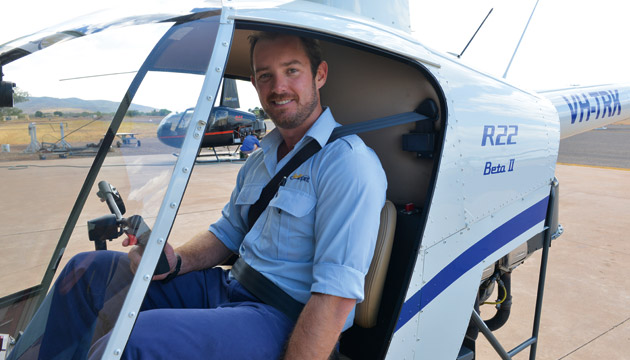In 2016, Kimberley helicopter company Helispirit started a pilot-training school with the aim of putting graduates straight into jobs with the company.
Story and photos by Ken Eastwood
Just a five-minute helicopter jaunt from Mitchell Falls – one of the “must-see” tourist icons of the Kimberley – Gareth Cope is hunkered down in a pilot’s bush camp beside a horned skull strapped to a tree and a bloke with earmuffs who’s playing guitar. A hundred metres away, tourists are bundled into choppers and whisked away over the fan palms and spinifex, on a ride of a lifetime to see the falls.
Gareth, the first graduate of the new Australian Helicopter Academy, has just been made one of the pilots who will take tourists to see the falls. He has joined Helispirit’s network of 25 bush chopper pilots, based at seven locations throughout Western Australia, in particular the Kimberley.
The organisation started the pilot-training academy in May 2016 in order to train quality pilots in the Kimberley for bush flying. “I did some flights around Brisbane and it’s just not the same,” Gareth says. “Helicopters are made to fly in the bush.”
To become a qualified helicopter pilot, students need to complete seven difficult theory subjects and then a minimum of 105 hours flying time. Gareth worked in construction for two years and took out a loan in order to get the money together for the course, then completed the theory and practical components over six months. He did his initial theory work in Brisbane, and then completed the practical component out at Kununurra with the academy. “I’ve always wanted to fly,” he says. “I always thought it would be helicopters. I didn’t want to be a glorified bus driver [a commercial fixed-wing pilot] driving people city to city sort of thing. Then I went for a flight in one and it was a no-brainer.”
Having grown up on a dairy farm, Gareth says he’d eventually love to get into helicopter mustering, but acknowledges that he’d need a bit of time mustering on the ground to learn the ropes. He’s also aiming for some of the other exciting helicopter work available. “Get into utility-type work: fire fighting, that sort of work – using them for what they’re for,” he says.
In the meantime, he’s stoked to be working in the Kimberley with Helispirit’s extensive tourist and other operations. “What an opportunity. I’d always wanted to come up here,” he says. “I was pretty lucky. I finished my licence and the next day they offered me a job. Not many people come out of a course and go straight into a job.”
Gareth’s instructor, James Bondfield, says that is one of the key aims of the academy. “We will select the most promising students from the academy to come into the company because they’re a known entity. We know their good points and bad points,” James says. Prior to 2016, Helispirit was finding that the junior pilots asking for jobs were highly variable in standard, and the company had to retrain many of the pilots who had learnt in other helicopter schools. “A lot of schools have got a lot of instructors with under 1000 hours total experience,” James says. “Between Howard James [the other instructor] and myself there’s 20,000 hours of flying experience.”
James, from a cattle and cropping property near Warwick, Qld, remembers getting the helicopter bug when he was at boarding school in Armidale, NSW. “I just remember trying to think about things to do for work experience and saw a helicopter flying one day, and I thought, ‘That guy’s sitting at his desk and getting paid for it’.”
This story excerpt is from Issue #110
Outback Magazine: Dec/Jan 2017










